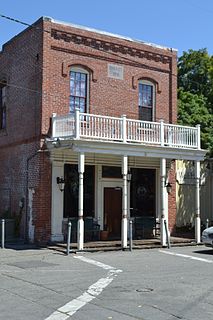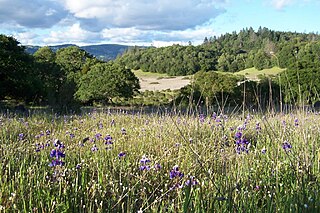
Sonoma County is a county in the U.S. state of California. As of the 2020 United States Census, its population was 488,863. Its county seat and largest city is Santa Rosa. It is to the north of Marin County and the south of Mendocino County. It is west of Napa County and Lake County.

Glen Ellen is a census-designated place (CDP) in Sonoma Valley, Sonoma County, California, United States. The population was 784 at the 2010 census, down from 992 at the 2000 census. Glen Ellen is the location of Jack London State Historic Park, Sonoma Valley Regional Park, and a former home of Hunter S. Thompson.

Santa Rosa is a city and the county seat of Sonoma County, in the North Bay region of the Bay Area in California. Its estimated 2019 population was 178,127. It is the largest city in California's Wine Country and Redwood Coast, as well as the fifth most populous city in the Bay Area after San Jose, San Francisco, Oakland, and Fremont; and the 25th most populous city in California.

Sonoma Valley is a valley located in southeastern Sonoma County, California, in the North Bay region of the San Francisco Bay Area. Known as the birthplace of the California wine industry, the valley is home to some of the earliest vineyards and wineries in the state, some of which survived the phylloxera epidemic of the 1870s and the impact of prohibition in the early 20th century. Today, the valley's wines are protected by the U.S. Federal Government's Sonoma Valley and Carneros AVAs.

The California State Railroad Museum is a museum in the state park system of California, United States, interpreting the role of the "iron horse" in connecting California to the rest of the nation. It is located in Old Sacramento State Historic Park at 111 I Street, Sacramento.

Fort Tejon in California is a former United States Army outpost which was intermittently active from June 24, 1854, until September 11, 1864. It is located in the Grapevine Canyon between the San Emigdio Mountains and Tehachapi Mountains. It is in the area of Tejon Pass along Interstate 5 in Kern County, California, the main route through the mountain ranges separating the Central Valley from the Los Angeles Basin and Southern California. The fort's location protected the San Joaquin Valley from the south and west.

Trione-Annadel State Park is a state park of California in the United States. It is situated at the northern edge of Sonoma Valley and is adjacent to Spring Lake Regional Park in Santa Rosa. It offers many recreational activities within its 5,092-acre (2,061 ha) property.

Kenwood, California is an unincorporated community and census-designated place (CDP) in Sonoma County, California, located on Sonoma Highway between the cities of Santa Rosa and Sonoma. It lies east of Sonoma Creek in the upper part of Sonoma Valley, a region sometimes called the Valley of the Moon. Bennett Mountain lies west of the town, and Sugarloaf Ridge to the northeast. The population was 1,028 at the 2010 census.

Sonoma Creek is a 33.4-mile-long (53.8 km) stream in northern California. It is one of two principal drainages of southern Sonoma County, California, with headwaters rising in the rugged hills of Sugarloaf Ridge State Park and discharging to San Pablo Bay, the northern arm of San Francisco Bay. The watershed drained by Sonoma Creek is roughly equivalent to the wine region of Sonoma Valley, an area of about 170 square miles (440 km2). The State of California has designated the Sonoma Creek watershed as a “Critical Coastal Water Resource”. To the east of this generally rectangular watershed is the Napa River watershed, and to the west are the Petaluma River and Tolay Creek watersheds.

Rancho Petaluma Adobe is a historic ranch house in Sonoma County, California. It was built from adobe bricks in 1836 by order of Mariano Guadalupe Vallejo. It was the largest privately owned adobe structure built in California and is the largest example of the Monterey Colonial style of architecture in the United States. A section of the former ranch has been preserved by the Petaluma Adobe State Historic Park and it is both a California Historic Landmark and a National Historic Landmark. The Rancho Petaluma Adobe State Historic Park is located on Adobe Road on the east side of the present-day town of Petaluma, California.

Sonoma Mountain is a prominent landform within the Sonoma Mountains of southern Sonoma County, California. At an elevation of 2,463 ft (751 m), Sonoma Mountain offers expansive views of the Pacific Ocean to the west and the Sonoma Valley to the east. In fact, the viticultural area extends in isolated patches up the eastern slopes of Sonoma Mountain to almost 1,700 feet (520 m) in elevation.

Jack London State Historic Park, also known as Jack London Home and Ranch, is a California State Historic Park near Glen Ellen, California, United States, situated on the eastern slope of Sonoma Mountain. It includes the ruins of a house burned a few months before Jack London and family were to move in, a cottage in which they had lived, another house built later, and the graves of Jack London and his wife. The property is both a California Historical Landmark and a National Historic Landmark.
Graham Creek is a 2.9-mile-long (4.7 km) perennial stream in Sonoma County, California, tributary to Sonoma Creek. Graham Creek rises in the northern Sonoma Mountains and flows generally northeasterly down the northeastern flank of Sonoma Mountain. Historically this watercourse was called Wild Water Creek, a name used in the time of author Jack London, some of whose work was inspired by the stream. Steelhead, Oncorhynchus mykiss, have historically entered Graham Creek via Sonoma Creek for spawning. Stream surveys conducted from 1966 to 1986 indicated significant, but declining populations of anadromous fish. The spawning habitat of Graham Creek is considered medium to high value, with both winter and summer sheltering characteristics.

Placerita Canyon State Park is a California State Park located on the north slope of the western San Gabriel Mountains, in an unincorporated rural area of Los Angeles County, near the city of Santa Clarita. The park hosts a variety of historic and natural sites, as well as serving as a trailhead for several hiking trails leading into the San Gabriel Mountains.
Rancho Los Guilicos was a 18,834-acre (76.22 km2) Mexican land grant in present-day Sonoma County, California given in 1837 by Governor Juan B. Alvarado to John (Juan) Wilson. The grant extended along Sonoma Creek, south of Santa Rosa from Santa Rosa Creek south to almost Glen Ellen, and encompassed present day Oakmont, Kenwood and Annadel State Park.
Transcendence Theatre Company is a professional regional theatre company founded in 2008 in Sonoma County, California. The company produces Broadway concerts and musicals.

Wolf House was a 26-room mansion in Glen Ellen, California, built by novelist Jack London and his wife Charmian London. The house burned on August 22, 1913, shortly before the Londons were planning to move in. Stone ruins of the never-occupied home still stand, and are part of Jack London State Historic Park, which has been a National Historic Landmark since 1963.
Sonoma County, California formally establishes landmarks through its Landmarks Commission.

The Santa Rosa and Carquinez Railroad was completed in 1888 from a terminal rail yard in Santa Rosa, California, through the Valley of the Moon to Sonoma, and then south through Schellville and east across the northern San Francisco Bay wetlands to a connection with the national rail network at Napa Junction north of Vallejo. The line was part of the Southern Pacific subsidiary Northern Railway until formally merged into the Southern Pacific in 1898. It was operationally known as Southern Pacific's Santa Rosa Branch or Sonoma Valley Branch. The railroad avoided the ferries of San Francisco Bay providing direct transportation to eastern markets for agricultural products of the Sonoma County wine region; and dimension stone from the basalt quarries in what is now Annadel State Park became a major source of freight revenue. The Santa Rosa terminal rail yard was on the north side of College Avenue approximately one mile northeast of the earlier Santa Rosa Downtown station now served by SMART.

Tilden Daken was an American landscape painter known for his oil paintings of the California redwoods, the Sierra Nevada mountains, and the countryside scenery of Northern California and Southern California. He also painted in Alaska, Mexico, Baja, the Hawaiian Islands, the South Seas, and parts of the East Coast of the United States.















